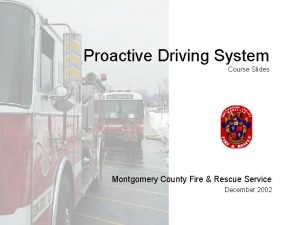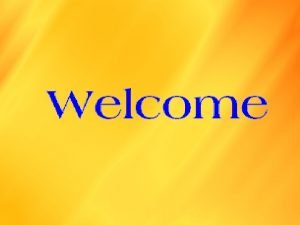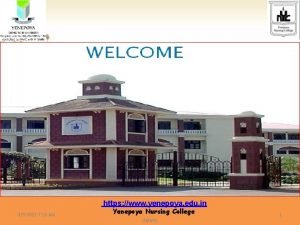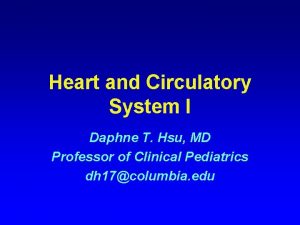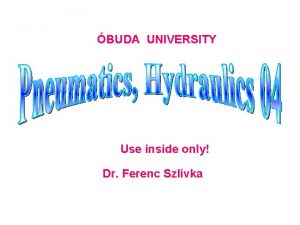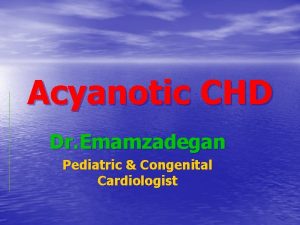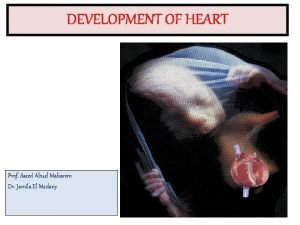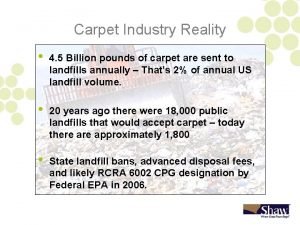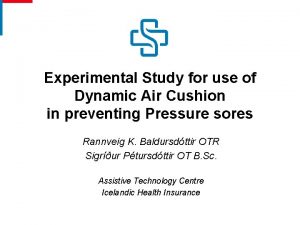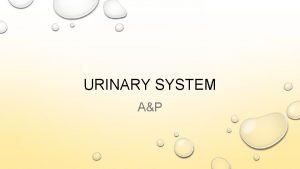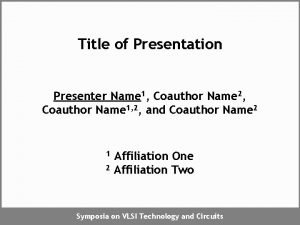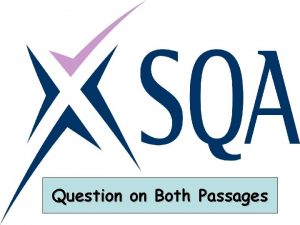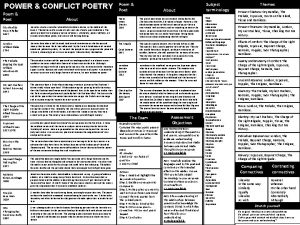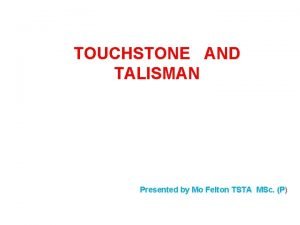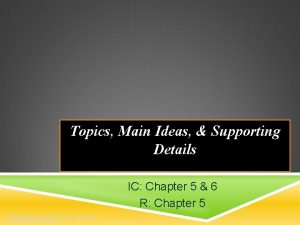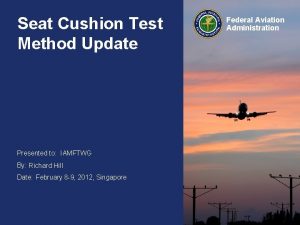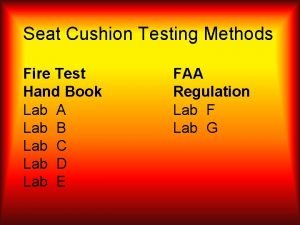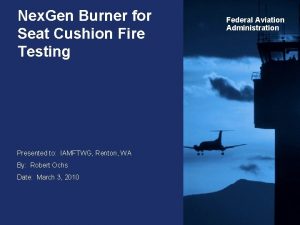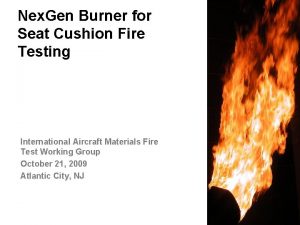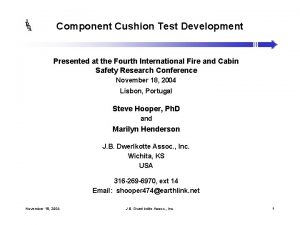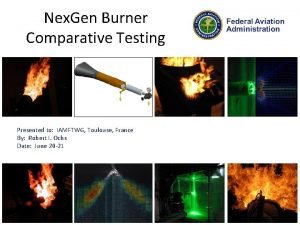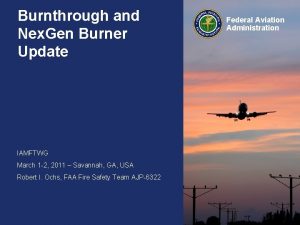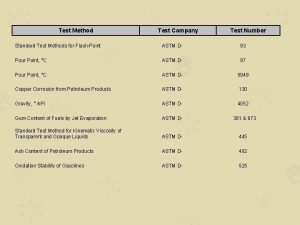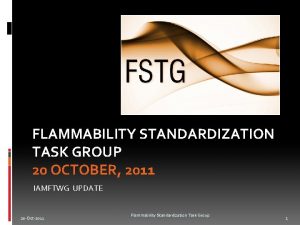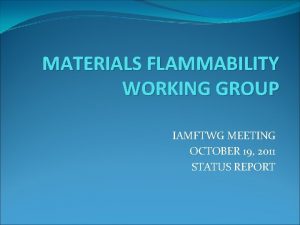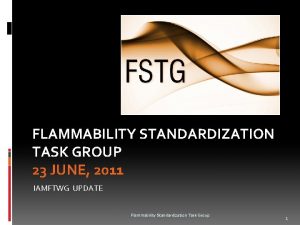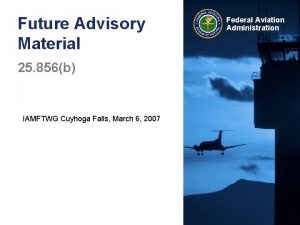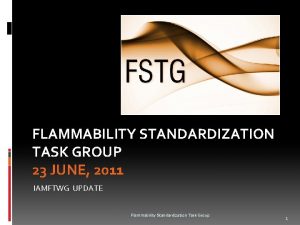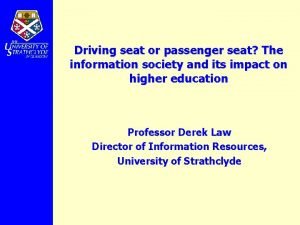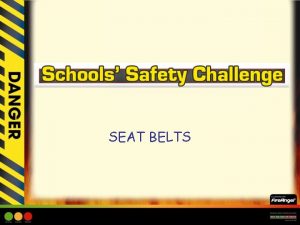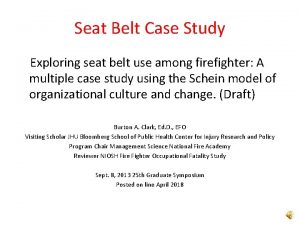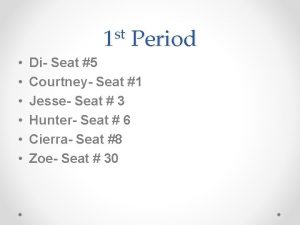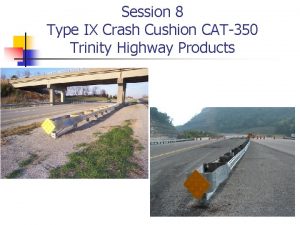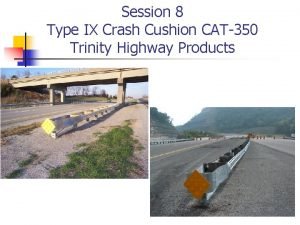Seat Cushion Test Method Update Presented to IAMFTWG























- Slides: 23

Seat Cushion Test Method Update Presented to: IAMFTWG By: Tim Salter Date: October 19 -20, 2011, Atlantic City, NJ Federal Aviation Administration

Introduction • Have been working to setup sonic burner for use with seat cushion test method for the purpose of replacing older style Park Burner • Testing has been ongoing in an attempt to setup the sonic burner such that it will reproduce Park burner test results • The advantage of the sonic burner is that it is capable of producing more consistent results than the Park burner Seat Cushion Test Method Update IAMFTWG, October 19 -20, 2011, Atlantic City, NJ Federal Aviation Administration 2 2

Summary • Flow testing new nozzles – Checking for consistency in flow rates • Testing nozzles in sonic burner – Nozzle clocking to check for uniform flame temperature distribution using thermocouple rake • Seat cushion tests using sonic burner – Data collected using old Park burner and Monarch nozzles will be compared to data taken using new nozzles and sonic burner – Check for similarity, and adjust sonic burner to reproduce Park data results Seat Cushion Test Method Update IAMFTWG, October 19 -20, 2011, Atlantic City, NJ Federal Aviation Administration 3 3

2. 0 gph Nex. Gen Burner Set-up • Fuel Pressure: 2. 0 gph (+/- 0. 1 gph) • 1/8” sheathed ceramic packed K type TCs • Test using an air pressure of 45 psi – Based on previous seat cushion test results using a 2. 0 gph Nex. Gen burner that were comparable to the Park Burner test results Seat Cushion Test Method Update IAMFTWG, October 19 -20, 2011, Atlantic City, NJ Federal Aviation Administration 4 4

2. 0 gph Nex. Gen Burner Setup Continued • Stator Positioning: Results – Rotational Location • Igniter centerline located 330 degrees clockwise from zero degrees (igniter vertical centerline) – Axial Location • Front face of stator located 3. 375 inches from front face of turbulator Seat Cushion Test Method Update IAMFTWG, October 19 -20, 2011, Atlantic City, NJ Federal Aviation Administration 5 5

2. 0 gph Nex. Gen Burner Set-up Continued • Configuration: Muffler and 90 degree elbow – The burner was fitted with a 90 degree elbow at the rear of the draft tube to reduce the space needed to run the device. This seemed to have an impact on the operation of the burner, and resulted in reduced TC temperatures, and erratic results. The muffler on the burner was repositioned in between the elbow and the draft tube. The muffler acts to smooth out the flow which was being disrupted by the 90 degree elbow. Seat Cushion Test Method Update IAMFTWG, October 19 -20, 2011, Atlantic City, NJ Federal Aviation Administration 6 6

Muffler and Elbow Configuration Before Seat Cushion Test Method Update IAMFTWG, October 19 -20, 2011, Atlantic City, NJ After Federal Aviation Administration 7 7

Proposed Burner Settings • Delevan B 2. 0 gph fuel nozzle – 2. 0 gph (+/- 0. 1 gph) • Air pressure: 45 psi • Stator rotation: 330 degrees from vertical centerline • Stator location: 3. 375” from turbulator exit plane • Muffler between burner tube and elbow Seat Cushion Test Method Update IAMFTWG, October 19 -20, 2011, Atlantic City, NJ Federal Aviation Administration 8 8

Fuel Nozzle Flow Test Rig • Fuel is pressurized to 100 psi, and fuel is collected for one minute then stopped. The reading on the graduated cylinder shows the number of milliliters that flow in one minute. This is then converted to gallons per hour. The actual fuel flow rate can then be compared to the rated flow rate of the nozzle. A higher quality nozzle will show a lower difference between actual and rated flow rates. Seat Cushion Test Method Update IAMFTWG, October 19 -20, 2011, Atlantic City, NJ Federal Aviation Administration 9 9

Fuel Nozzle Flow Rate • Delevan Nozzle Flow Check – The Delevan nozzles were checked on a bench top flow testing rig. The results show, that compared to the typical Monarch nozzles, the Delevan nozzles have a much lower percent error. – Delevan 2. 0 gph error: 4. 09% – Monarch 2. 25 gph error: 13. 59% – Further testing with different nozzles is ongoing. • 25 Everloy 2. 0 gph-rated hollow cone nozzles were also tested, and produced results similar to the Delevan nozzles. Seat Cushion Test Method Update IAMFTWG, October 19 -20, 2011, Atlantic City, NJ Federal Aviation Administration 10 10

Delavan Nozzle Flow Test Results • • • Average = 1. 92 Std Dev = 0. 04 %SD = 1. 89% Seat Cushion Test Method Update IAMFTWG, October 19 -20, 2011, Atlantic City, NJ Federal Aviation Administration 11 11

Nozzle Clocking Summary • Monarch nozzles are not uniform around the spray cone periphery • Delavan nozzles seem to provide more uniform spray pattern through 360° nozzle rotation – Delevan flame temperatures are lower (~100°F) than Monarch flame – Previously recorded lower temperatures partially due to old thermocouples – Temperatures for the Delevan nozzles increased after replacing old thermocouples with new ones Seat Cushion Test Method Update IAMFTWG, October 19 -20, 2011, Atlantic City, NJ Federal Aviation Administration 12 12

Burner and Nozzle Calibration Seat Cushion Test Method Update IAMFTWG, October 19 -20, 2011, Atlantic City, NJ Federal Aviation Administration 13 13

Burner and Nozzle Calibration Seat Cushion Test Method Update IAMFTWG, October 19 -20, 2011, Atlantic City, NJ Federal Aviation Administration 14 14

Seat Testing with Burner • Sonic Burner was then used to burn seat test cushions using Delevan and Everloy Nozzles • The Park burner was also used to test seat cushions with the Monarch nozzle • The goal is to adjust the sonic burner such that it produces similar results as the Park burner Seat Cushion Test Method Update IAMFTWG, October 19 -20, 2011, Atlantic City, NJ Federal Aviation Administration 15 15

Results Seat Cushion Test Method Update IAMFTWG, October 19 -20, 2011, Atlantic City, NJ Federal Aviation Administration 16 16

Thermocouple Temperature Drift • Extreme thermal cycling can cause thermocouples to display an increased error in readings • Exposing a SS sheathed 1/8” TC to a flame over 7 separate temperature tests showed a decrease in temperature reading of ~80 degrees Fahrenheit • Met with representatives from TC supplier, and are working on a solution to the problem – Develop new thermocouple more suited to withstand extreme thermal cycling • Type K thermocouples remain accurate under constant temperatures, or conditions where temperatures do not change by hundreds of degrees in a time period of only a few seconds Seat Cushion Test Method Update IAMFTWG, October 19 -20, 2011, Atlantic City, NJ Federal Aviation Administration 17 17

Seat Cushion Test Method Update IAMFTWG, October 19 -20, 2011, Atlantic City, NJ Federal Aviation Administration 18 18

Thermocouple Temperature Drift Seat Cushion Test Method Update IAMFTWG, October 19 -20, 2011, Atlantic City, NJ Federal Aviation Administration 19 19

New Air and Fuel Cooling System • Ice chest filled with ice water was not cold enough to keep fuel temperatures within specification • New freezer setup keeps fuel temperatures within spec during summer months – Fuel not stored in temperature controlled area • Simplified operation, longer operating periods – No longer have to keep filling chest with ice, and not limited by capacity of ice maker Seat Cushion Test Method Update IAMFTWG, October 19 -20, 2011, Atlantic City, NJ Federal Aviation Administration 20 20

New Air and Fuel Cooling System Seat Cushion Test Method Update IAMFTWG, October 19 -20, 2011, Atlantic City, NJ Federal Aviation Administration 21 21

Future Adjustments and Testing • Continue to test using thermocouples and seat test articles • Adjust sonic burner based on test results • Keep in consideration that not all seat test articles are manufactured the same • Fiberboard seat cushion testing – Fiberboard seat cushion fitted with 40 thermocouples will be used to generate a 3 D temperature model Seat Cushion Test Method Update IAMFTWG, October 19 -20, 2011, Atlantic City, NJ Federal Aviation Administration 22 22

Questions? Seat Cushion Test Method Update IAMFTWG, October 19 -20, 2011, Atlantic City, NJ Federal Aviation Administration 23 23
 What is an alternative of log based recovery
What is an alternative of log based recovery Space cushion driving
Space cushion driving Fibres of pdl
Fibres of pdl Comfort devices bibliography
Comfort devices bibliography Endocardial cushion defect
Endocardial cushion defect Cushion treemaps
Cushion treemaps Pneumatic systems
Pneumatic systems Endocardial cushion defects
Endocardial cushion defects Medany makarem
Medany makarem Shaw cushion worx
Shaw cushion worx Dynamic air cushions
Dynamic air cushions The kidneys are protected by the ribs and a cushion of fat
The kidneys are protected by the ribs and a cushion of fat Importance of symposium in education
Importance of symposium in education Types of news headlines
Types of news headlines Presentation name
Presentation name Setting dr jekyll and mr hyde
Setting dr jekyll and mr hyde Romeo and juliet love themes
Romeo and juliet love themes Which idea is presented in both passages?
Which idea is presented in both passages? Presenter title
Presenter title Juxtaposition in ozymandias
Juxtaposition in ozymandias Jerome bruner cognitive theory
Jerome bruner cognitive theory Hyde as an outsider
Hyde as an outsider Talisman presented
Talisman presented Main idea and supporting details definition
Main idea and supporting details definition

